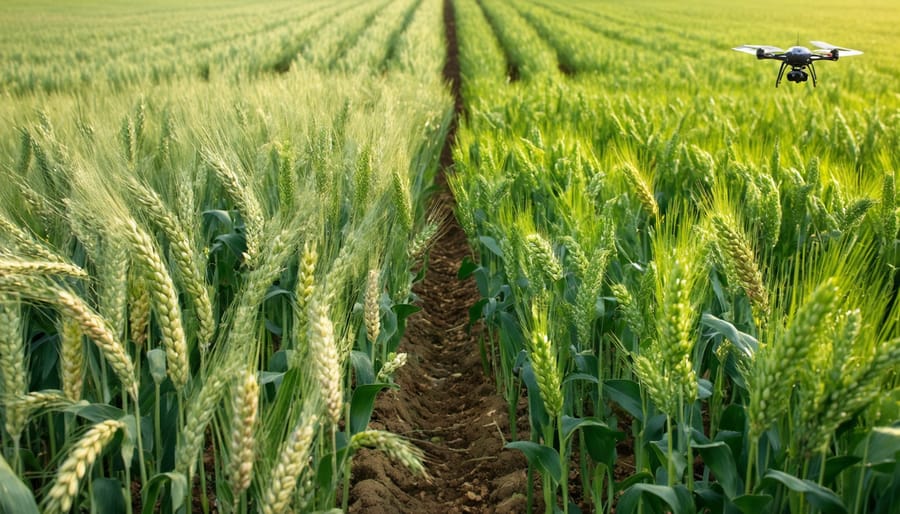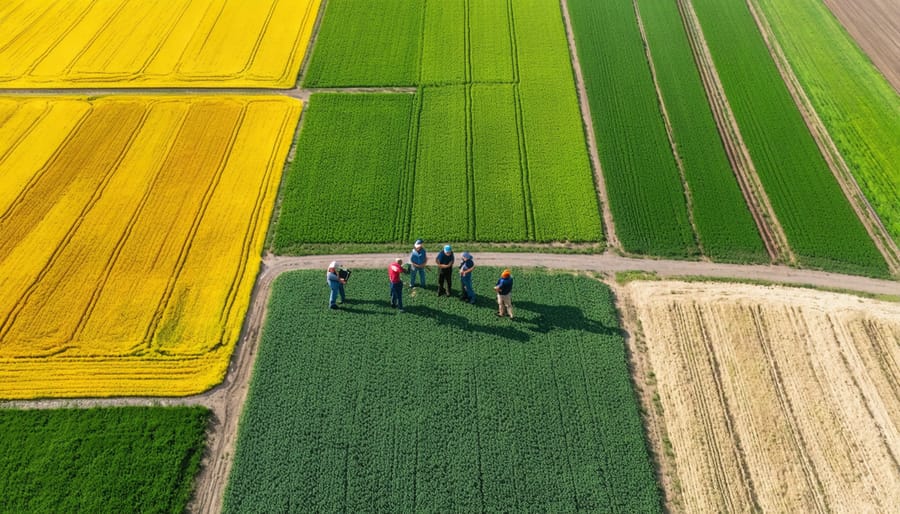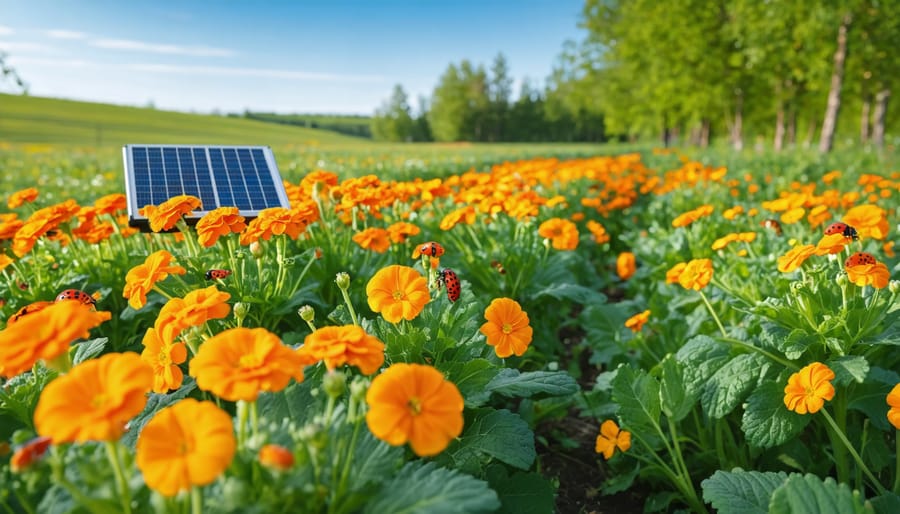Climate change poses unprecedented challenges to our healthcare infrastructure, demanding an urgent transformation in how we design, operate, and maintain medical facilities. Building climate-resilient health systems isn’t just about protecting buildings—it’s about safeguarding our ability to deliver essential care when communities need it most.
Across Canada, healthcare providers are already witnessing the impacts of extreme weather events, from flooded emergency departments to power outages disrupting critical care services. Alberta’s healthcare facilities, particularly in rural areas, face unique vulnerabilities to wildfires, floods, and severe storms that can isolate communities from vital medical services.
A climate-resilient health system combines robust infrastructure with flexible operating procedures, ensuring continuous care delivery despite environmental challenges. This means implementing renewable energy systems, developing comprehensive emergency response protocols, and creating redundant supply chains for essential medical supplies.
The stakes couldn’t be higher: our healthcare system’s resilience directly impacts patient outcomes, community well-being, and the ability of medical professionals to perform their life-saving work. As we face increasingly unpredictable weather patterns and environmental challenges, building climate resilience into our health systems isn’t just an option—it’s a critical investment in our collective future.
The Foundation of Climate-Resilient Farm Health
Monitoring and Early Warning Systems
In today’s rapidly changing climate, effective monitoring and early warning systems are crucial for maintaining healthy agricultural operations. Modern smart monitoring technologies are transforming how Alberta farmers detect and respond to potential threats before they become major issues.
Weather stations equipped with soil moisture sensors and temperature monitors provide real-time data that helps predict disease-favorable conditions. Many Alberta farmers are now using automated pest traps with digital cameras that send instant alerts when specific insects are detected. These systems integrate with smartphone apps, allowing farmers to monitor their fields remotely and receive timely notifications.
Local agricultural extension services have established regional disease forecasting networks that combine field observations with weather data to predict potential outbreaks. This collaborative approach has proven particularly effective in managing fusarium head blight in wheat and clubroot in canola.
Satellite imaging and drone surveillance are also becoming increasingly accessible, helping farmers spot unusual patterns in crop health that might indicate emerging pest or disease problems. These tools, combined with regular field scouting, create a comprehensive monitoring system that strengthens farm resilience against climate-related challenges.
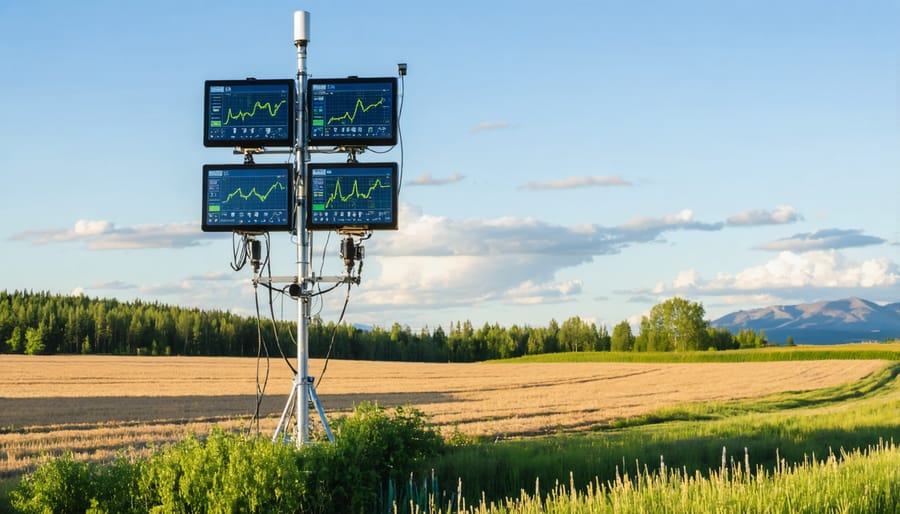
Adaptive Infrastructure Design
Modern agricultural infrastructure must evolve to withstand increasingly unpredictable weather patterns. Across Alberta, farmers are implementing innovative designs that protect both livestock and crops. For example, the Brown family farm near Lethbridge recently installed a high-tunnel greenhouse system with reinforced polycarbonate panels rated for heavy snow loads and high winds, allowing year-round production despite extreme conditions.
Weather-resistant barn designs now incorporate features like improved ventilation systems with automated temperature control, helping maintain optimal conditions during both heat waves and cold snaps. Several dairy operations in Central Alberta have adopted these systems, reporting increased milk production and reduced stress on their herds.
Storage facilities are being upgraded with moisture-resistant materials and elevated foundations to prevent flood damage. The Richardson farm in Red Deer showcases an excellent example with their new grain storage facility, built 1.5 metres above ground level and equipped with temperature monitoring systems.
Water management infrastructure has also evolved, with farms implementing drought-resistant irrigation systems and water capture methods. These include computerized drip irrigation and rainwater harvesting systems that can store up to 50,000 litres for use during dry periods.
Alberta’s Success Stories: Real Farm Solutions
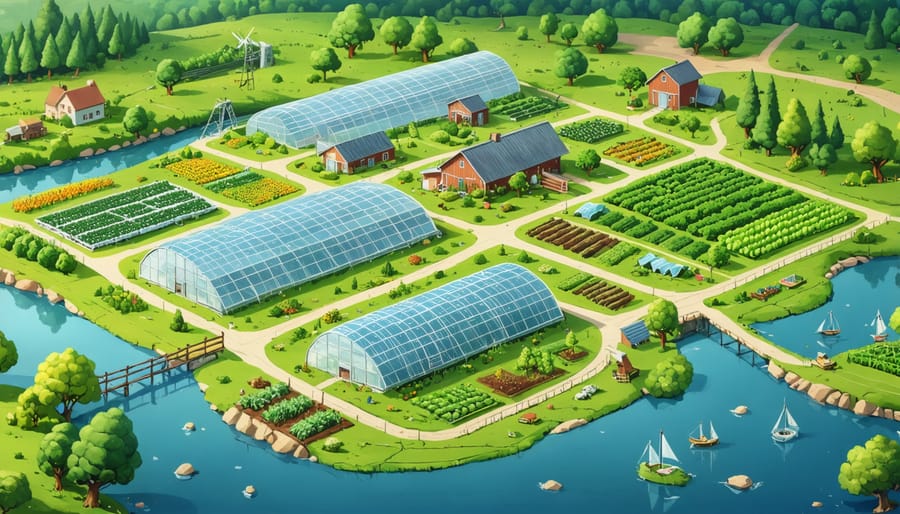
The Thomson Family Farm Transformation
Located just outside of Lacombe, Alberta, the Thomson Family Farm has become a beacon of climate resilience in Canadian agriculture. In 2018, after experiencing three consecutive years of extreme weather events, including severe drought and unseasonable frost, the Thomsons decided to transform their 800-hectare grain operation into a climate-adaptive farm system.
The family’s first step was implementing precision irrigation technology, reducing water usage by 40% while maintaining crop yields. They installed soil moisture sensors across their fields and integrated weather monitoring systems to optimize irrigation scheduling. This technology proved crucial during the 2021 drought, helping them preserve their canola crop while neighboring farms struggled.
The Thomsons also diversified their crop selection, introducing drought-resistant varieties of wheat and incorporating pulse crops into their rotation. They established shelter belts using native trees and shrubs, which now protect their fields from wind erosion and provide wildlife habitat. Their innovative approach includes using cover crops during shoulder seasons to improve soil health and reduce erosion.
Perhaps most notably, the family invested in renewable energy, installing solar panels that now power their irrigation systems and grain storage facilities. They’ve also implemented a comprehensive water management plan, including the construction of retention ponds that capture spring runoff for use during dry periods.
Today, the Thomson farm serves as a demonstration site for climate-resilient agriculture, hosting regular workshops for local farmers interested in implementing similar systems.
Community-Based Disease Management
In Alberta’s farming communities, the power of collective action has proven invaluable in managing agricultural health challenges. Local farmer groups are increasingly adopting collaborative pest management approaches that leverage shared resources and knowledge to combat regional threats effectively.
These community-based initiatives typically involve regular meetings where farmers share observations, coordinate monitoring efforts, and develop unified response strategies. For example, the Lacombe County Disease Watch Network has successfully reduced clubroot spread by implementing synchronized crop rotation schedules and sharing equipment cleaning protocols among its members.
Modern technology enhances these collaborative efforts through digital platforms where farmers can report disease outbreaks in real-time. The Alberta Pest Surveillance Network exemplifies this approach, with over 2,000 farmers using a mobile app to track and respond to emerging pest threats collectively.
Success stories include the Wheat Stem Sawfly Management Group in southern Alberta, where participating farms have reduced crop losses by 60% through coordinated timing of harvesting and resistant variety deployment. Similarly, the Red Deer River Valley Disease Prevention Coalition demonstrates how shared weather monitoring stations and coordinated fungicide applications can effectively manage fusarium head blight across multiple properties.
These community-based systems prove that when farmers work together, they create more resilient agricultural operations better equipped to face climate-related challenges.
Practical Implementation Steps
Assessment and Planning
Building a climate-resilient health system starts with a thorough assessment of your farm’s current vulnerabilities and strengths. Begin by documenting weather-related challenges you’ve faced in recent years, such as drought periods, flooding, or extreme temperature events. Consider how these events have impacted your livestock health, crop yields, and overall farm operations.
Work with local agricultural extension services to conduct a comprehensive risk assessment. In Alberta, the Agricultural Financial Services Corporation (AFSC) offers valuable resources for evaluating climate-related risks specific to your region. Pay special attention to your water management systems, soil health indicators, and existing emergency response protocols.
Create a detailed inventory of your current health management practices, including vaccination schedules, disease monitoring systems, and pest control measures. This baseline information will help identify gaps in your current approach and areas that need strengthening.
Develop your action plan by prioritizing the most critical vulnerabilities identified in your assessment. Set realistic timelines and allocate resources accordingly. Consider both short-term solutions, like improving ventilation systems in livestock buildings, and long-term investments, such as developing drought-resistant pastures.
Include measurable goals in your plan, such as reducing heat stress-related livestock health issues by 50% within two seasons. Establish monitoring systems to track progress and adjust strategies as needed. Remember to involve your entire farm team in the planning process – their practical experience and insights are invaluable.
Many successful Alberta farmers recommend creating seasonal checklists for implementing different aspects of your climate resilience plan, making it easier to stay on track throughout the year.
Resource-Efficient Solutions
Building climate resilience doesn’t always require substantial financial investments. Many Alberta farmers have successfully implemented cost-effective strategies that work within their existing budgets. By focusing on preventative measures and utilizing proven natural solutions, farms can enhance their resilience while maintaining financial stability.
Start with soil health improvements through cover cropping and crop rotation, which typically cost less than $50 per acre while providing multiple benefits. These practices reduce the need for expensive synthetic inputs and build long-term resilience. Many farmers report saving 15-20% on fertilizer costs within the first two years of implementation.
Water management solutions can be surprisingly affordable. Simple techniques like contour farming and mulching help retain moisture and prevent erosion. Installing rain gauges and soil moisture sensors, costing around $200-500, can optimize irrigation timing and reduce water usage by up to 30%.
Consider joining equipment-sharing programs or cooperatives, which have gained popularity across Alberta. These arrangements can reduce individual farm equipment costs by 40-60% while maintaining access to essential machinery. Local agricultural extension offices often facilitate these connections at no cost.
Energy efficiency improvements offer another budget-friendly approach. LED lighting upgrades and regular equipment maintenance can reduce energy costs by 25-35% annually. Many utility companies offer rebates or cost-sharing programs for energy-efficient upgrades.
Take advantage of free resources through provincial agricultural programs, including workshops, soil testing services, and consultation with agricultural experts. These services can help identify farm-specific opportunities for building resilience without straining your budget.
Remember, implementing changes gradually allows for better cost management and helps ensure sustainable adoption of new practices. Start with solutions that offer the highest return on investment for your specific operation.
Future-Proofing Your Farm
Emerging Technologies
Canadian farmers are increasingly adopting innovative technologies to build climate-resilient agricultural systems. Smart sensors and IoT devices now enable real-time monitoring of soil health, moisture levels, and crop conditions, helping farmers make data-driven decisions. These systems can detect early signs of stress or disease, allowing for prompt intervention before problems escalate.
Precision agriculture tools, including GPS-guided equipment and drone technology, are revolutionizing field management. These technologies help optimize resource use while reducing environmental impact. Farmers can apply water, fertilizers, and other inputs with unprecedented accuracy, leading to better yields and reduced waste.
Advanced weather monitoring systems, combined with AI-powered forecasting, provide detailed microclimate data specific to individual farm locations. This technology helps farmers prepare for extreme weather events and adjust their management practices accordingly.
Integration of biological control methods with digital monitoring systems is showing promising results across Alberta farms. These integrated approaches help maintain beneficial insect populations while reducing pesticide use.
Mobile apps and farm management software are making it easier to track and analyze farm data, from crop rotation schedules to pest management strategies. These tools help farmers build more resilient operations by providing insights into long-term trends and supporting informed decision-making for future seasons.

Building Adaptive Capacity
Building a resilient agricultural health system requires ongoing learning and adaptation. Across Alberta, farmers are increasingly participating in workshops and training programs focused on climate-responsive farming techniques. These educational opportunities help producers stay current with emerging best practices and innovative solutions.
Local agricultural extension offices offer regular training sessions on monitoring soil health, implementing water conservation strategies, and managing livestock during extreme weather events. Many of these programs are developed in collaboration with experienced farmers who understand the unique challenges of the Canadian prairies.
The Alberta Federation of Agriculture has established a mentorship network connecting seasoned farmers with those looking to enhance their climate resilience practices. This knowledge-sharing approach has proven particularly effective, as demonstrated by the success of the Morrison family farm in Lethbridge, which improved crop yields by 30% after implementing adaptive management strategies learned through the program.
Resources for continuous improvement include online learning platforms, regional climate data tools, and seasonal planning guides specifically designed for Alberta’s agricultural zones. Regular farm assessments help identify areas for improvement, while community support groups provide opportunities to share experiences and solutions.
Remember that building adaptive capacity is an ongoing process. Start with small, manageable changes and gradually expand your climate-resilient practices as you gain confidence and expertise. Your local agricultural office can help connect you with relevant training opportunities and resources.
Building climate-resilient health systems on our farms isn’t just about protecting our operations – it’s about securing the future of Canadian agriculture. Throughout this guide, we’ve explored practical strategies that Alberta farmers can implement to strengthen their agricultural systems against climate challenges.
The key to success lies in taking incremental steps. Start by assessing your farm’s specific vulnerabilities and implementing the most feasible solutions first. Whether it’s improving soil health, diversifying crops, or upgrading irrigation systems, every action contributes to greater resilience.
Remember that you’re not alone in this journey. Connect with local agricultural extension services, join farmer-led initiatives, and share experiences with neighbouring farms. The collective knowledge of our farming community is one of our greatest resources.
Moving forward, consider developing a climate resilience action plan for your farm. Set realistic goals, monitor progress, and adjust strategies as needed. Take advantage of available government programs and resources designed to support climate-smart farming practices.
Most importantly, stay informed about emerging technologies and best practices. The agricultural landscape is constantly evolving, and staying current helps ensure your farm remains adaptable and sustainable.
By working together and implementing these strategies, we can build stronger, more resilient farming operations that will continue to thrive for generations to come. Your efforts today will help secure a sustainable future for Canadian agriculture.




